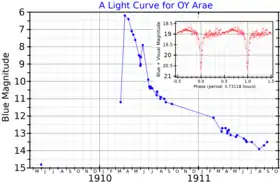 A light curve for OY Arae. The main plot (from data published by Walker and Shapley)[1] shows the 1910 eruption, and the inset plot (adapted from Zhao and McClintock)[2] shows the eclipse light curve measured in 1995. | |
| Observation data Epoch J2000 Equinox J2000 | |
|---|---|
| Constellation | Ara |
| Right ascension | 16h 40m 50.456s[3] |
| Declination | −52° 25′ 47.98″[3] |
| Apparent magnitude (V) | 18.7[4] |
| Characteristics | |
| Apparent magnitude (B) | 6.0 – 18.6[5] |
| B−V color index | −0.15[6] |
| Variable type | Nova + eclipsing[5] |
| Astrometry | |
| Proper motion (μ) | RA: −3.689[3] mas/yr Dec.: −3.182[3] mas/yr |
| Parallax (π) | 0.2676 ± 0.0714 mas[3] |
| Distance | approx. 12,000 ly (approx. 3,700 pc) |
| Absolute magnitude (MV) | −6.7 (at peak) 4.6 (quiescent)[7] |
| Orbit | |
| Period (P) | 3.72936 h[8] |
| Semi-major axis (a) | 1.28±0.04 R☉[2] |
| Inclination (i) | 74.3±1.2[2]° |
| Details | |
| white dwarf | |
| Mass | 0.82±0.12[2] M☉ |
| donor | |
| Mass | 0.34±0.01[2] M☉ |
| Other designations | |
| Database references | |
| SIMBAD | data |
OY Arae, also known as Nova Arae 1910, is a nova in the constellation Ara. It was discovered by Williamina Fleming on a Harvard Observatory photographic plate taken on April 4, 1910. At that time it had a magnitude of 6.0, making it faintly visible to the naked eye under ideal observing conditions. Examination of earlier plates showed that before the outburst it was a magnitude 17.5 object, and by March 19, 1910, it had reached magnitude 12.[9][2]
OY Arae is considered to be a moderately fast nova, because it faded by 3 magnitudes during the 83 days after discovery.[10][9] The light curve shows a secondary maximum in June 1910. The first spectrum of the nova was obtained on July 5, 1910, and resembled that of a gaseous nebula.[11] An optical identification of the quiescent nova was made in 1994, and spectra taken at that time showed strong Balmer lines in emission atop a blue continuum.[2]
All novae are binary stars, with a "donor" star orbiting a white dwarf. The two stars are so close to each other that material is transferred from the donor to the white dwarf. Because the distance between the two stars is comparable to the radius of the donor star, novae are often eclipsing binaries, and OY Arae does show eclipses. The primary eclipse, in which the donor star eclipses the white dwarf and its accretion disk, are about 2 magnitudes deep and last less than 30 minutes. The orbital period is 3.73118 hours. The mass of the white dwarf is 0.82±0.12 M☉, and the mass of the donor star is 0.34±0.01 M☉. The two stars are separated by 1.28±0.04 R☉.[2]
Most of the luminosity of the system is produced by the disk of material being stripped from the donor star. This is estimated to be 7 magnitudes brighter than the donor star itself, with the white dwarf being even fainter. The absolute magnitude of the system is given as +4.6, but this value is distorted by the shape of the disk, seen nearly edge-on. A mean absolute magnitude adjusted for viewing angle is +3.6.[2]
References
- ↑ Walker, Arville D.; Shapley, Harlow (January 1933). "The photographic light curves of thirteen novae". Annals of Harvard College Observatory. 84 (7): 189–206. Bibcode:1933AnHar..84..189W.
- 1 2 3 4 5 6 7 8 9 Zhao, Ping; McClintock, Jeffrey E. (July 1997). "A Dynamical Study of the Eclipsing Nova OY Arae". The Astrophysical Journal. 483 (2): 899–906. Bibcode:1997ApJ...483..899Z. doi:10.1086/304283. S2CID 119710755.
- 1 2 3 4 5 Vallenari, A.; et al. (Gaia collaboration) (2023). "Gaia Data Release 3. Summary of the content and survey properties". Astronomy and Astrophysics. 674: A1. arXiv:2208.00211. Bibcode:2023A&A...674A...1G. doi:10.1051/0004-6361/202243940. S2CID 244398875. Gaia DR3 record for this source at VizieR.
- ↑ Howell, Steve B.; Mason, Elena (2018). "On the MV-Inclination Relationship for Nova-like Variables". The Astronomical Journal. 156 (5): 198. arXiv:1808.08170. Bibcode:2018AJ....156..198H. doi:10.3847/1538-3881/aadd13. S2CID 54503839.
- 1 2 "OY Ara". The International Variable Star Index. AAVSO. Retrieved 6 October 2022.
- ↑ Duerbeck, H. W.; Seitter, W. C. (March 1987). "A Survey of Nova Remnants". Astrophysics and Space Science. 131 (1–2): 467–473. Bibcode:1987Ap&SS.131..467D. doi:10.1007/BF00668127.
- ↑ Warner, Brian (July 1987). "Absolute magnitudes of cataclysmic variables". Monthly Notices of the Royal Astronomical Society. 227: 23–73. Bibcode:1987MNRAS.227...23W. doi:10.1093/mnras/227.1.23.
- ↑ Sparks, Warren M.; Sion, Edward M. (2021). "Nova-produced Common Envelope: Source of the Nonsolar Abundances and an Additional Frictional Angular Momentum Loss in Cataclysmic Variables". The Astrophysical Journal. 914 (1): 16. arXiv:2103.14149. Bibcode:2021ApJ...914....5S. doi:10.3847/1538-4357/abf2bc. S2CID 232380319.
- 1 2 Duerbeck, Hilmar W. (March 1987). "A Reference Catalogue and Atlas of Galactic Novae". Space Science Reviews. 45 (1–2): 1–14. Bibcode:1987SSRv...45....1D. doi:10.1007/BF00187826. S2CID 115854775.
- ↑ Duerbeck, H. W. (April 1981). "Light curve types, absolute magnitudes, and physical properties of galactic novae". Publications of the Astronomical Society of the Pacific. 93: 165–175. Bibcode:1981PASP...93..165D. doi:10.1086/130799. S2CID 121397724.
- ↑ Cannon, Annie Jump; Pickering, Edward Charles (1916). "Spectra having bright lines". Annals of the Astronomical Observatory of Harvard College. 76 (3): 19–42. Bibcode:1916AnHar..76...19C.